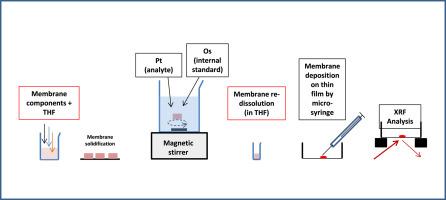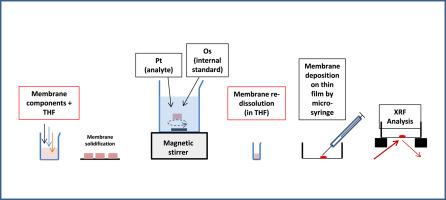Optimization of complexing membranes for platinum analysis in water at part per trillion levels by X-ray fluorescence
IF 5.7
2区 化学
Q1 CHEMISTRY, ANALYTICAL
引用次数: 0
Abstract
Background
Platinum is a critical metal, especially in medicine and catalysis. Its concentration in aquatic ecosystems may gradually affect aquatic animals due to its ability to bioaccumulate. Additionally, the recycling of platinum has become crucial, so new extraction methods are needed. In recent years, there has been increasing interest in environmental studies based on X-Ray Fluorescence, due to the requirements of green chemistry. Complexing membranes have been used for platinum analysis in combination with X-ray Fluorescence, although with a relatively high detection limit.
Results
Several optimizations were introduced to achieve a significantly improved detection limit and repeatability. Self-supported membranes were used for the first time and proved to be highly effective in binding platinum from aqueous solutions. An extensive search was conducted to identify an appropriate chemical element to serve as an internal standard; osmium met many of the necessary criteria and was successfully used as an internal standard, leading to a remarkable improvement in the method's precision. The effect of various elements present in natural waters was examined, and no interferences were observed. The method gave equally reliable results in all types of water, including seawater. Through substantial optimization procedures, a minimum detection limit up of 37 ng L−1 was achieved with a 1000 s irradiation time. The potential aging of the membrane was investigated, showing that the membrane does not deteriorate for at least one month when stored at refrigeration temperature.
Significance
The newly introduced self-supported complexing membranes improved the platinum detection limit by more than 100-fold, enabling, for the first time, platinum analysis at low ng L−1 concentration levels using X-ray Fluorescence. This method can be used to various types of natural waters, including seawater with near-complete recovery from the aquatic matrix. This research may also contribute to improving the minimum detection limits of the method for other trace elements besides platinum.


通过 X 射线荧光法优化用于万亿分之一级水中铂分析的络合膜
背景铂是一种重要的金属,尤其是在医药和催化领域。由于铂具有生物蓄积性,其在水生生态系统中的浓度可能会逐渐影响水生动物。此外,铂金的回收利用已变得至关重要,因此需要新的提取方法。近年来,由于绿色化学的要求,人们对基于 X 射线荧光的环境研究越来越感兴趣。络合膜已被用于结合 X 射线荧光进行铂金分析,但检测限相对较高。首次使用了自支撑膜,并证明它能非常有效地从水溶液中结合铂。为了找到一种合适的化学元素作为内标,进行了广泛的搜索;锇符合许多必要的标准,并成功地被用作内标,从而显著提高了该方法的精确度。对天然水中存在的各种元素的影响进行了研究,没有发现任何干扰。该方法在包括海水在内的所有类型的水中都能得出同样可靠的结果。通过大量的优化程序,在照射时间为 1000 秒的情况下,最低检测限可达到 37 纳克/升。新推出的自支撑络合膜将铂金检测限提高了 100 多倍,首次实现了利用 X 射线荧光法在低纳克/升浓度水平下分析铂金。这种方法可用于各种类型的自然水体,包括海水,几乎能从水生基质中完全回收。这项研究还有助于提高该方法对铂以外的其他微量元素的最低检测限。
本文章由计算机程序翻译,如有差异,请以英文原文为准。
求助全文
约1分钟内获得全文
求助全文
来源期刊

Analytica Chimica Acta
化学-分析化学
CiteScore
10.40
自引率
6.50%
发文量
1081
审稿时长
38 days
期刊介绍:
Analytica Chimica Acta has an open access mirror journal Analytica Chimica Acta: X, sharing the same aims and scope, editorial team, submission system and rigorous peer review.
Analytica Chimica Acta provides a forum for the rapid publication of original research, and critical, comprehensive reviews dealing with all aspects of fundamental and applied modern analytical chemistry. The journal welcomes the submission of research papers which report studies concerning the development of new and significant analytical methodologies. In determining the suitability of submitted articles for publication, particular scrutiny will be placed on the degree of novelty and impact of the research and the extent to which it adds to the existing body of knowledge in analytical chemistry.
 求助内容:
求助内容: 应助结果提醒方式:
应助结果提醒方式:


